Gallery
Feature
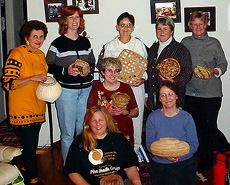
THE BASKET BUNCH:
A "Vine" Gathering
in Southern Maryland
by Pamela Zimmerman and Lynn Hoyt

THE BASKET BUNCH:
A "Vine" Gathering
in Southern Maryland
by Pamela Zimmerman and Lynn Hoyt
NEW!!!Guidelines for Gathering: Collecting 101, by basketmaker and teacher Kay Harradine!
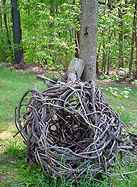
Click here to see more of Nancys' woven outdoor decorations |
The garden, alone, shows that a free spirit basketmaker lives here. Witness the garden balls, pure whimsy, like huge nests of some exotic bird. They rest here and there, with plants growing through them, or filled with gourds too brittle, thin or deteriorated to use for craft. On the edge of the yard there are more of these woven balls. These are flatter and less hollow, but still very attractive. Nancy says, "...oh yes, that is what happens to them, eventually they collapse." It is all part of the circle ... they are gifts from nature, just like the plant from which they were made, these random "pods" will eventually return to the ground.
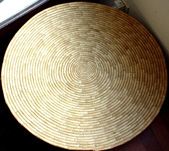 Click here to see more of Nancy's collections! |
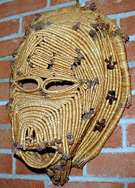 Click here to see more of Nancys masks and other creations! |
During our "tour", a flat coiled disc draws the eye(above left)...obviously African, definitely a "functional" basket. By this, I mean not a basket made for the tourist trade, i.e., a money-maker someone else wants to buy... no, this is a basket made to be used. I am right, Nancy says, "it was my husband's from a long time ago (he was born raised in Africa), and is very old..." There are no "wraps" alone, each stitch connects the coil to the one beneath it. There was a specific task which needed to be done, and this basket was made to accomplish that bit of daily living. It was carefully constructed of the best available material, attending to what would WORK. Here is a basket to get the job done, which was used for years.
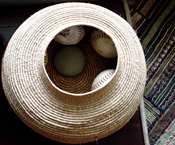 Click here to see more of Nancy's baskets! |
Nancy generally uses raffia (natural or dyed in earthy tones ) to create closed coil forms, with pine needles as core. She tends to favor the figure eight stitch, sometimes leaving "the caps on", but in clusters poking out from the tightly bound bundle. Her style is disarmingly plain,letting the form of the basket speak for itself in a simply elegant fashion.
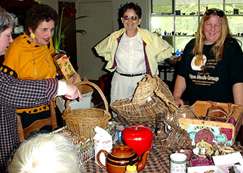 More group members are trickling in, bringing samples of their own baskets. Back in the living/dining room, it is "show and tell"...We are looking at a bark strip basket ... made of Balm of Gilead. "They call it a trash tree, the bark comes off very easily", says Jean. No one has to say what this means: pure gold in the natural basketmaker's book. Something to file away to REMEMBER, to learn by heart so that when it is seen it is recognized. The detritus
of the gardener, the thing that people absolutely cannot believe you want when they have piled it by the street, waiting for trash pickup. The stuff growing in the back forty, and the homeowner would love to eradicate the stuff, but cannot. It is almost physically impossible to make it go away... you can cut and cut and it will always come back. The list is long: kudzu, wisteria, honeysuckle, dandelions ... we learn them and love them. We hope that we can turn these, the most base of materials, into something fabulous and unusual and ... treasured.
More group members are trickling in, bringing samples of their own baskets. Back in the living/dining room, it is "show and tell"...We are looking at a bark strip basket ... made of Balm of Gilead. "They call it a trash tree, the bark comes off very easily", says Jean. No one has to say what this means: pure gold in the natural basketmaker's book. Something to file away to REMEMBER, to learn by heart so that when it is seen it is recognized. The detritus
of the gardener, the thing that people absolutely cannot believe you want when they have piled it by the street, waiting for trash pickup. The stuff growing in the back forty, and the homeowner would love to eradicate the stuff, but cannot. It is almost physically impossible to make it go away... you can cut and cut and it will always come back. The list is long: kudzu, wisteria, honeysuckle, dandelions ... we learn them and love them. We hope that we can turn these, the most base of materials, into something fabulous and unusual and ... treasured.
|
- Luther Standing Bear |
We are getting to the "meat" of this gathering. Most of these baskets are never sold. They find their places in the hearts and homes of the makers, performing common, necessary functions ... holding the potatoes or the pushpins, scraps of paper or dirty shoes, and are accepted and cherished for what they are, perhaps especially for the experience of turning something unwanted into a marvelous, one of a kind, and perhaps useful keepsake.
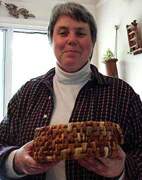 Click here to see Ruth's baskets! |
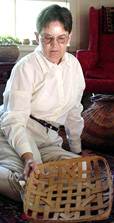 Click here to see more of Jean's baskets! |
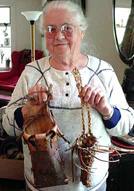 Click here to see more of Persis baskets! |
Here is Persis Suddeth, who said, in her workshop, "there is no wrong way, whatever you do is right!" Persis has quite a free hand with her designs. Many of her creations are small, unassuming, and not standard shapes. She shares several little stake and strand pieces, interesting cornucopias which make use of naturally branching vines (two or three or four branchings in a single strand, artfully integrated into the basket plan.) Small bark baskets which hang on the wall, little pouches of woodland. But when we come to share our baskets it is Persis who says, "What would you use this basket for?" It suddenly occurs to me, she is the one who is making all these designs which appear to be pure fantasy, and yet she is using them all. The potato basket, asymmetrical, perched on it's side like a split melon? It is used for potatoes, every day, and here is the evidence - the bottom is starting to rot from the potatoes which have sat there too long. It does not matter. Persis says that next time she teaches that basket, she will remove and reweave that section. Some of her pieces are purple, bright and disarming in their contrast to the natural ones. What are they dyed with? All natural plant dyes... brambles...blackberries that the group collected, in a Ruth Matthews-led project, boiled up in canning pots and camp stoves in the back yard. Sure enough, a few of the group have that purple in a basket or two. A little discussion about natural dyes ensues. Some baskets were dyed whole, others constructed from dyed materials. What a scene that must have been!
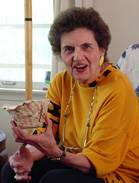 Click here to see more of Audrey's Baskets and other projects! |
Several times we hear of Dick Smith, whose annual leadership into the bark basket is anticipated with great excitement. Dick chooses trees to remove from his own property. One year, birch. Another year, Tulip Poplar, Cherry, Pine...this year will be Sumac. Then the bunch will strip the bark, immediately, and fashion into ... whatever. The most amazing baskets are those of the single, huge sheet of bark. Now they are older, like a piece of wood, hard as a piece of firewood, with all the character of the mother tree. The bark is taken in a sheet, all the way up to 12x24, and scored to allow it to bend. You have to be careful to only score through the outer bark, leaving the inner bark intact. Making two opposing archs, the outer bark is then gently folded away, the scored arches making the bottom edges of the bucket, the inner bark holding it all together. The sides are lashed or bound together. As we have over and over, we ask " what is this binding the sides", and the answer is almost invariably, "Oh. Uh, I can 't remember..whatever it is that is flexible enough to hold it."
Dick pushes the bunch into showing at the local fairs, bringing the group's pieces collectively and entering them enmasse, making participation a real breeze! Ruth says "He says the prizes probably don't pay for gas, but we do end up with a slew of ribbons!", and the group says he is probably responsible for them striving to improve and try new things from year to year. "Some (of the bark baskets) are very sophisticated, not just the crude single folded sheet baskets....Usually," says Ruth, "Dick's baskets are the best! But we are catching up with him, after all these years of him encouraging us to show our baskets at the fairs!" I am drooling...
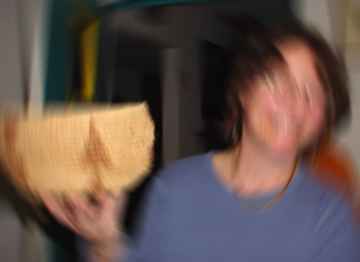 As if the baskets bonanza were not enough, we are treated to the most scrumptious vegetarian potluck dinner. We unabashedly stuffed ourselves, sitting in Nancy's living room, talking and absorbing the energy of the evening, surrounded by new friends. The buzz of excitement in the sharing was almost overwhelming.
As if the baskets bonanza were not enough, we are treated to the most scrumptious vegetarian potluck dinner. We unabashedly stuffed ourselves, sitting in Nancy's living room, talking and absorbing the energy of the evening, surrounded by new friends. The buzz of excitement in the sharing was almost overwhelming.
As we left in the twilight, we drive through rolling green hills, tangled in the lushness of their heritage. The woods are filled with vines and runners and quickly-growing trees. They are the product of rich soil, clear days, abundant rain. It is dazzlingly verdant and growing, a wealth of material for the naturals basketmaker. We are seeing the beauty of these places with the new eye, those of the novice basket maker. We are in a whirl of basketmaking thought...can a basket be made of that?
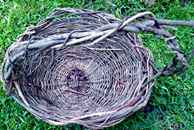 Lynn and I have been in a tizzy of natural basketmaking. It really is a wonderful, creative outlet, and not difficult to do, even all by yourself.
Lynn and I have been in a tizzy of natural basketmaking. It really is a wonderful, creative outlet, and not difficult to do, even all by yourself. Please make sure you know what you are gathering - at least to identify potentially poisonous or irritating plants in the area you will be gathering. Wild vines can be used green - that is, fresh picked.
Instructions for making Wicker, Rib, or Random weave baskets are in most basket books, and can be checked out of a library.
If you are interested in learning a technique using a kit, we recommend Wild Pony Basket Kitsİ, www.wildponybaskets.com . Both Lynn and I learned wicker techniques using these kits. They are paper-based, require no water, and are illustrated with step-by-step photographs. Some of our favorite picks are Little Riverİ, Little Patriotİ, and Little Flowerİ. If you want to learn to make rib baskets, try the Little Rounderİ! You will not need a teacher, I guarantee.
Here are some of our first "vine" efforts. What fun!
The Basket Bunch is a group sponsored by Patuxent River Park, through The Maryland National Park and Planning Commission, Department of Parks and Recreation, Prince Georges County, Maryland. They meet the third Thursday each month, at various locations. Most meetings include a collecting trip in the morning followed by the basket making session. Visitors are always welcome. For more information about the Basket Bunch and other programs sponsored by Patuxent River Park, please call Stephanie Kopin at (301) 627-6074. NEW!!!Guidelines for Gathering: Collecting 101, by basketmaker and teacher Kay Harradine!
Home
Members
Pine Needle Basket Links
Other Coiled Forms
Resource Links
History & Technical Links
Forums Exchanges
Mailing List
Web design by Pamela Zimmerman